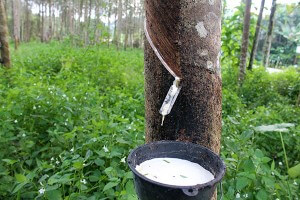Is it Rubber, or is it Wood?

From: Eco Toys
Rubberwood may sound like something from the future, but has actually been around for decades. This eco-friendly material is on the rise, so let's brush up on the nature of this tricky wood.
Where does it come from?

From: Kevin Carmody
Rubberwood is actually a type of hardwood. It comes from the Para rubber tree. The Para rubber tree is grown in plantations, or farms that grow these trees for their latex sap. After about 30 years of maturing, the Para rubber trees' latex sap production slows down.
The trees are cut down, replaced, and the process begins anew. The wood from these Para trees is similar to teak and black walnut. But because rubberwood is a sustainable product, it is sometimes preferred over teak.
Rubberwood Uses
But what happens to the trees when they run out of moneymaking latex sap and are cut down? Rubberwood happens!
Before Smokey the Bear, Captain Planet, Al Gore, and the rise of the environmentalism movement, the trees were simply burned. Now, the trees are recycled and used in many wood-related products, from cutting boards to toys.

From: Coach Barn

From: Costless Warehouse
Caring for Your Wood
First things first, DO NOT leave rubberwood furniture outdoors. As with many other wood species, too much moisture will cause the wood to warp, expose it to fungus, and rotting.
Careful not to overheat rubberwood. Like my exposed skin at a Hawaii beach, direct sunlight can discolor the wood surface and finish badly.
Cleaning methods are the same as with other wood species. Dents can be common on wood surfaces, and not to mention very annoying. Check out this Instructable on how to remove a dent from wood. Before you try this method, make sure that it's not just a shallow one. If it only affects the finish then try applying more finish or varnish. If the finish is lacquer, then use lacquer to repair it.

From trev25 on Instructable
Rubberwood is a sustainable, recycled hardwood. It's very durable with a Janka hardness rating of 980 newtons. It is cost effective and an outstanding base for painting. Its straight grain pattern makes it a Paint Grade material.
By: Luis Leonzo
